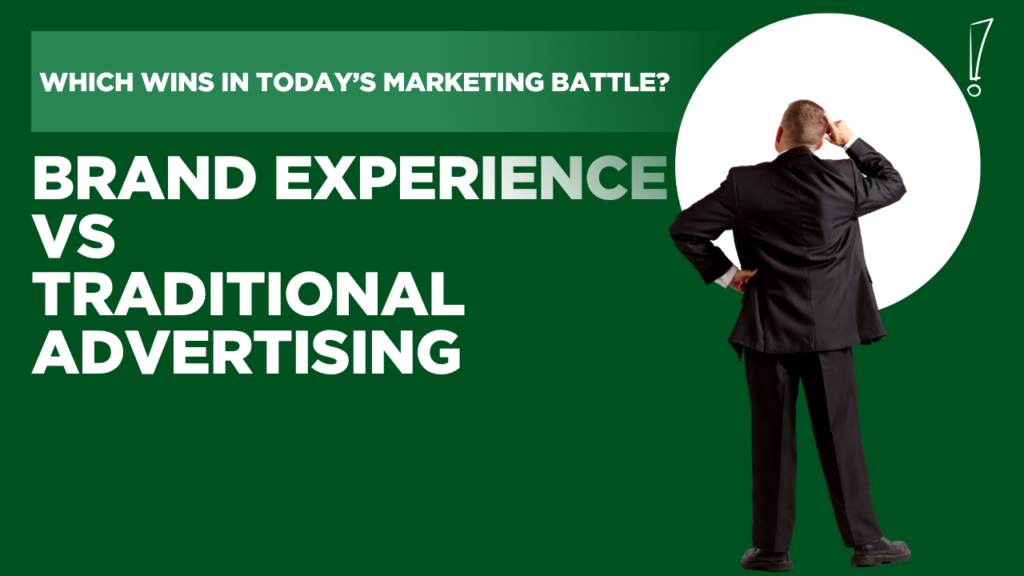
In a world bombarded by ads, the question is no longer just how to reach your audience—but how to connect with them. The marketing battleground is shifting from passive consumption to immersive experiences. In this blog, we dive deep into the debate: Brand Experience vs Traditional Advertising – Which Wins?
Understanding the Concepts – What Are We Comparing?
What is Traditional Advertising?
Traditional advertising refers to paid promotional content delivered through conventional media channels such as:
- Television commercials
- Radio spots
- Newspaper and magazine ads
- Billboards and print flyers
It focuses on message push, relying on repetition and placement to capture attention.
What is Brand Experience?
Brand experience is the sum total of interactions a customer has with a brand—designed to evoke emotion, build relationships, and drive loyalty. This includes:
- Experiential marketing events
- Interactive campaigns
- Product packaging
- Customer service and physical store ambiance
- Immersive digital experiences (e.g., AR/VR)
It’s about engagement, not interruption.
Key Differences – Brand Experience vs Traditional Advertising
| Aspect | Traditional Advertising | Brand Experience |
| Focus | Reach and frequency | Engagement and immersion |
| Channel | Paid media | Owned/earned channels, events, digital touchpoints |
| Customer Role | Passive observer | Active participant |
| Goal | Awareness and short-term conversion | Loyalty and long-term relationship |
| Measurement | Impressions, clicks, reach | Dwell time, sentiment, NPS, repeat interaction |
The Power of Brand Experience – Why It’s Winning Hearts
H3: 1. Emotional Connection Over Repetition
Brand experiences tap into human emotion—creating a memory that lasts far longer than a 30-second TV ad.
Example: Coca-Cola’s “Share a Coke” campaign personalized bottles with names, prompting people to hunt for and share bottles with loved ones—creating a personal, emotional connection.
2. Higher Customer Retention
People remember how a brand made them feel. This emotional resonance translates into higher retention rates and brand advocacy.
3. Shareability in the Social Era
Experiences are Instagrammable, tweetable, and TikTokable. Traditional ads might be skipped, but a great brand experience is shared across platforms, generating organic reach.
Where Traditional Advertising Still Holds Power
1. Mass Reach
If your goal is to reach millions overnight, TV, radio, and billboards still have unmatched scale—especially in tier-2 and tier-3 cities.
2. Simplicity and Speed
Launching a product? A well-crafted ad with the right media buy can instantly inform the audience without needing participation.
3. Great for Awareness Campaigns
Traditional ads excel in creating top-of-the-funnel awareness, especially when combined with digital strategies.
The Hybrid Approach – Why Smart Brands Use Both
Many winning brands today blend both methods for maximum impact:
- Nike’s traditional “Just Do It” ads build mass awareness, while their in-store experiences and community events create emotional loyalty.
- Apple’s TV spots create intrigue, but it’s their store design, packaging, and product experience that builds love.
Metrics That Matter – Measuring Success
Traditional Advertising Metrics
- Reach & Frequency
- Cost Per Mille (CPM)
- Return on Ad Spend (ROAS)
- Brand Recall Surveys
Brand Experience Metrics
- Net Promoter Score (NPS)
- Sentiment Analysis
- Engagement Time
- Social Sharing & Earned Media
- Customer Lifetime Value (CLV)
Insight: Traditional advertising gives you quantifiable visibility. Brand experience gives you qualitative depth.
Q&A – Frequently Asked Questions
Q1: Is brand experience more expensive than traditional advertising?
A: Not necessarily. While experiential campaigns may require logistics and creativity, many digital brand experiences (like gamified apps or AR filters) offer cost-effective engagement compared to high-budget TV or print media.
Q2: Can small businesses implement brand experience marketing?
A: Absolutely! A local café offering a unique in-store ambiance, personalized notes with orders, or an interactive loyalty app is already crafting brand experience. It’s about creativity, not budget.
Q3: Which one is better for a product launch—brand experience or traditional advertising?
A: A mix works best. Use traditional ads to announce the launch and brand experiences to create buzz, trial, and loyalty.
Q4: Does traditional advertising still work in the digital age?
A: Yes—but context matters. In rural areas or for older demographics, TV, print, and radio remain powerful. It’s about understanding your audience.
Final Verdict – Which One Wins?
In the battle of Brand Experience vs Traditional Advertising, there’s no absolute winner. It’s not a war—it’s a strategy mix.
- If your goal is reach, speed, and control, traditional advertising still delivers.
If your goal is engagement, loyalty, and long-term brand equity, brand experience is the game-changer.

